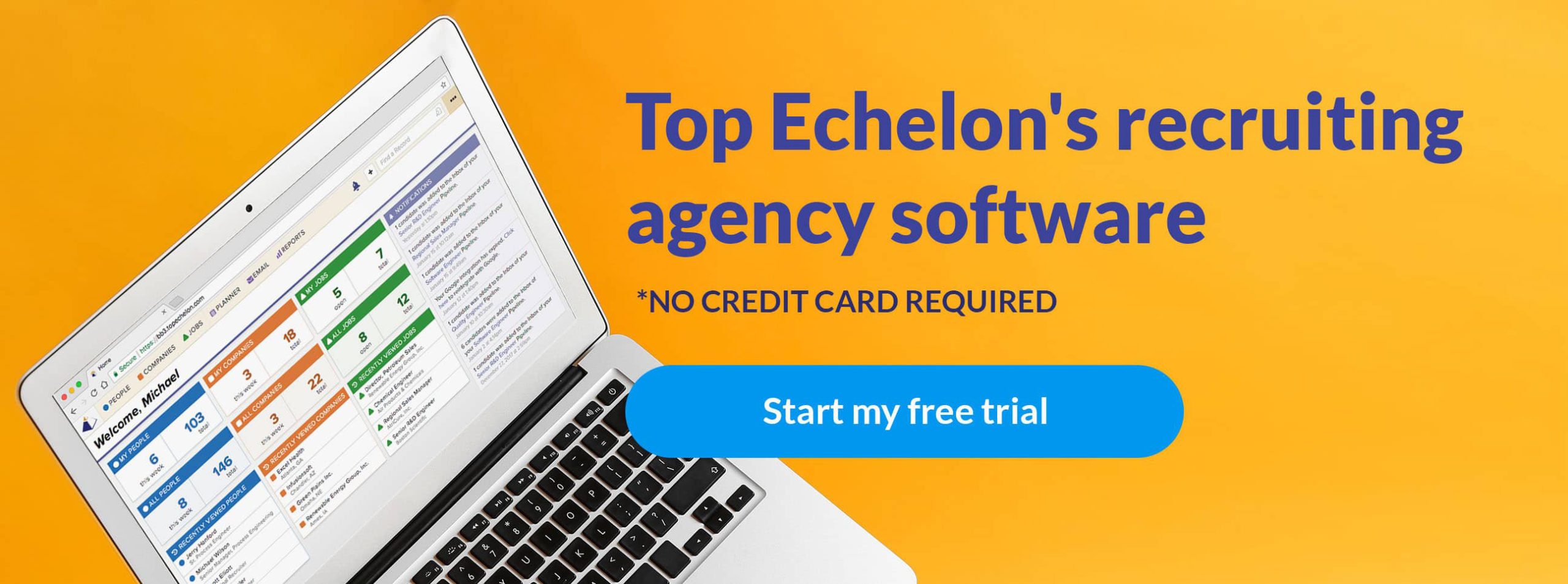Recruiting isn’t as simple as finding a job-seeking individual, getting them to apply, and placing them in the open position. When you’re hired to fill a job order, there are different steps involved in making a placement. Full cycle recruiting starts with accepting a job order and ends when the client onboards a candidate you found. What is full cycle recruiting?
What is full life cycle recruiting?
Full cycle recruiting is the recruitment process from start to finish. It is a multiple-step operation that ends in a successful job placement. Steps in the process include sourcing and interviewing candidates. A hiring authority, like a recruiter, who is part of the recruiting process every step of the way completes a full recruitment life cycle.
As a recruiter, most job orders you receive will be full cycle recruiting since you do not outsource steps of the job placement process. Feel free to make a recruitment workflow diagram to keep you accountable.
Here are the different steps of full cycle recruiting:
Step 1: Receive job order from your client
The first step of full life cycle recruiting is to receive the job order from your client. Your client should give you a detailed job description with the job order so you know what you are looking for.
If your client’s job description does not clearly address the type of position, person needed, or qualifications, you might need to re-write it. The job description should have the job title, salary range, ideal candidate specifics, and a summary of the job.
Re-writing the job description might take some back and forth between you and your client, but it is necessary. You won’t be able to do your job successfully and attract the right candidates if the job description is sloppy.
Once you receive a job order from your client, along with a job description you can work with, you can move onto the next step.
Step 2: Search for and recruit candidates
When you have a job order, you can start your search for candidates. Take some time to identify the ideal candidate you are searching for.
Sourcing candidates doesn’t have to be impossible. There are many different ways you can find candidates:
- Use recruiting software: Look for candidates within your recruiting database.
- Post on online job boards: Since 79% of job-seeking Americans use online resources to job hunt, put the job description online to attract more candidates.
- Incorporate social media: As part of your social media recruiting strategy, post the job description on social platforms to let passive candidates (people who aren’t actively job searching) know about the open job.
- Attend career fairs: Make face-to-face connections with job hunters at recruiting networking events and collect resumes.
Sometimes, your client needs a candidate with specific skills. Sourcing an A-level candidate is going to take some more time than finding just any candidate. Qualified candidates are more likely to receive multiple job offers and have different companies recruiting them. It might take more effort recruiting top-notch candidates and convincing them to work for your client.
Step 3: Narrow down results
After you find a decent-sized pool of interested candidates, you need to start screening them to see who will be interviewed. This part of the process is important, as you might get dozens of resumes belonging to unqualified applicants.
In order to pass along the most qualified candidates to your client, you need to first narrow down the results of your sourcing. For example, if you received 175 resumes, you could narrow them down to 15 candidates after thorough resume screening.
You can weed out candidates who do not match the job description if you have recruiting software. Recruiting software with an integrated ATS (applicant tracking system) will parse resumes, extracting information and putting it into a uniform format. The software then ranks candidates by who is the most qualified for the position.
Also, you can screen candidates by talking with them over the phone. Ask them about their qualifications and check to see if their expectations of the job align with the job itself.
Step 4: Join interviewing efforts
To find the candidate that best fits their company, your client should have multiple rounds of interviews. You should conduct a phone interview before inviting candidates to interview with your client face-to-face.
Though you won’t be the person actually asking candidates the questions in the interview, you can still be a part of the process. If your client wants you to, you can sit in on interviews, take notes, and provide feedback.
Step 5: Extend a job offer
When your client decides on a candidate, they will ask you to extend a job offer. You can act as a mediator between client and candidate salary expectations.
A candidate might feel more comfortable receiving an offer from you as opposed to the client since you were their main contact through the hiring process. If a candidate is on the fence about accepting the position, you can help qualm their fears and do what you can to make sure they are satisfied, like negotiate salary (based on your agreement with the client).
Step 6: Place the candidate
The recruitment life cycle isn’t over; the next step of full cycle recruiting is to make a successful placement. If the candidate declines the job offer, the process is not a successful end-to-end recruitment cycle.
You must place the candidate in order for it to be considered a full cycle recruiting process. If you don’t know how to close a candidate on a consistent basis, learn what recruiting leaders suggest. Once the candidate accepts the job offer, the recruiting cycle is ready to come to an end.
Step 7: Be part of onboarding
Maintaining your contact with the new hire can help prevent employee turnover. If you are part of the onboarding process, you can answer any questions the hire has or address any issues they’ve encountered.
For a successful placement, your client wants the new hire to stay with their company. By touching base with the new hire and making sure they are comfortable, you can smooth over problems and help the client retain talent.



